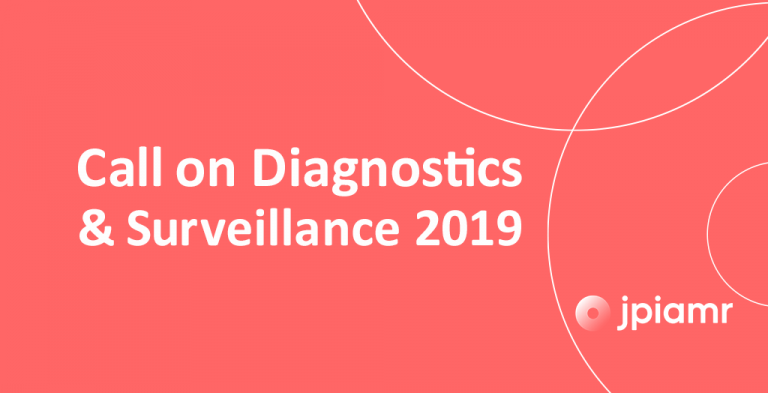The Call on Diagnostics and Surveillance 2019 will fund joint transnational research projects addressing the development of diagnostic and surveillance tools, technologies and methods to detect antimicrobial resistance (AMR). Projects should address the diagnosis of AMR infections in clinical and veterinary settings, or the surveillance of AMR in humans, animals and the environment. The call promotes projects with impact in low and middle income countries (LMICs) in Asia and Africa.

AMR has become one of the major global health and development challenges of the 21st century. The threat of AMR is particularly high in resource-limited and high-risk settings. This is linked to issues such as weak human and animal health systems; diverse means of food production, processing and consumption; food safety and food security; water, hygiene and sanitation challenges; and the global movement of people and goods.
In response to these challenges, the JPIAMR is pleased to launch this joint transnational call for proposals for innovative research projects on new or improved diagnostic and surveillance strategies, tools, technologies and methods. The call will support research projects that also have the potential for impact in areas where the risk and burden of AMR is greatest, such as in LMIC settings in Asia and Africa. Projects are encouraged to use a One Health approach where relevant.
The projected call budget is approx. 20.06 million Euro.
Scope of the call
Projects should aim to either:
- Develop strategies, tools, technologies, and methods for the detection, monitoring, profiling and/or surveillance of antimicrobial resistance and dynamics leading to resistance.
- Study ways to facilitate and implement the uptake and use of existing strategies, tools, technologies, and/or methods for the detection, monitoring, profiling and surveillance of antimicrobial resistance and dynamics leading to resistance.
Expected Outcomes
It is expected that this JPIAMR call will contribute to the urgent need to curb the burden associated with the most prioritised infections in different geographical settings. This topic area is also suitable to reinforce collaborations involving industry and social sciences. Regional LMIC led collaborations are welcomed. The results of the funded projects should contribute to improved understanding, monitoring and detection of AMR where efforts to curb AMR will have a global impact.
Suggested Focal Areas
- Establish the validity of new or improved diagnostic tools, technologies and methods.
- Evaluate how new or improved diagnostics can promote more prudent use of antibiotics (e.g. narrow spectrum antibiotics) in human and veterinary use
- Rapid diagnostics (essential for optimal antimicrobial selection) and point-of-care techniques, to improve personalised or individual therapies
- Development of new, or more efficient use and accessibility of already existing, tools, technologies and/or methods to detect AMR in multiple reservoirs, for example human, animal and environmental samples
Projects are encouraged to consider the global use of the tools, technologies and methods, including use in low and lower middle income settings (e.g. lack of laboratory facilities, affordable diagnostic tests, unreliable or unavailable electricity supplies or points-of-care-tests).
The following sub-topics are not within the scope of the call:
- Investigations based on, or involving, clinical trials.
- Investigations aiming to improve existing commercial technology or products (more details on this will be in the full call text and annexes)
Information & application
This call is closed.
Related material
Filmed interviews with some of the project leaders of the funded projects can be found here: Discover the projects of the JPIAMR transnational Joint Call on Diagnostics and Surveillance: Interviews with project leaders February 2019
Funders
Canada
Canadian Institute of Health Research (CIHR)
Canada’s International Development Research Centre (IDRC)
Czech Republic
Ministry of Education, Youth and Sports of the Czech Republic
Denmark
Innovation Fund Denmark
Finland
Academy of Finland
France
French National Research Agency (ANR)
Germany
The Federal Ministry of Education and Research (BMBF)
Israel
Ministry of Health (CSO-MOH)
Italy
Italian Ministry of Health
Italian Ministry for Education, University and Research
Latvia
State Education Development Agency
The Netherlands
The Netherlands Organisation for Health Research and Development (ZonMw)
The Netherlands Organisation for Scientific Research
Norway
The Research Council of Norway (RCN)
Poland
National Science Center
Romania
Ministry of Research and Innovation
South Africa
South African Medical Research Council
Spain
Instituto de Salud Carlos III
Sweden
Swedish International Development Cooperation Agency (Sida)
Swedish Research Council (SRC)
Supported projects
Twelve projects were funded within the JPIAMR 9th transnational call: “Call on Diagnostics and Surveillance 2019”. The total funding amount was 12,1 M€. Click on the project titles in the list below to learn more on each project.

